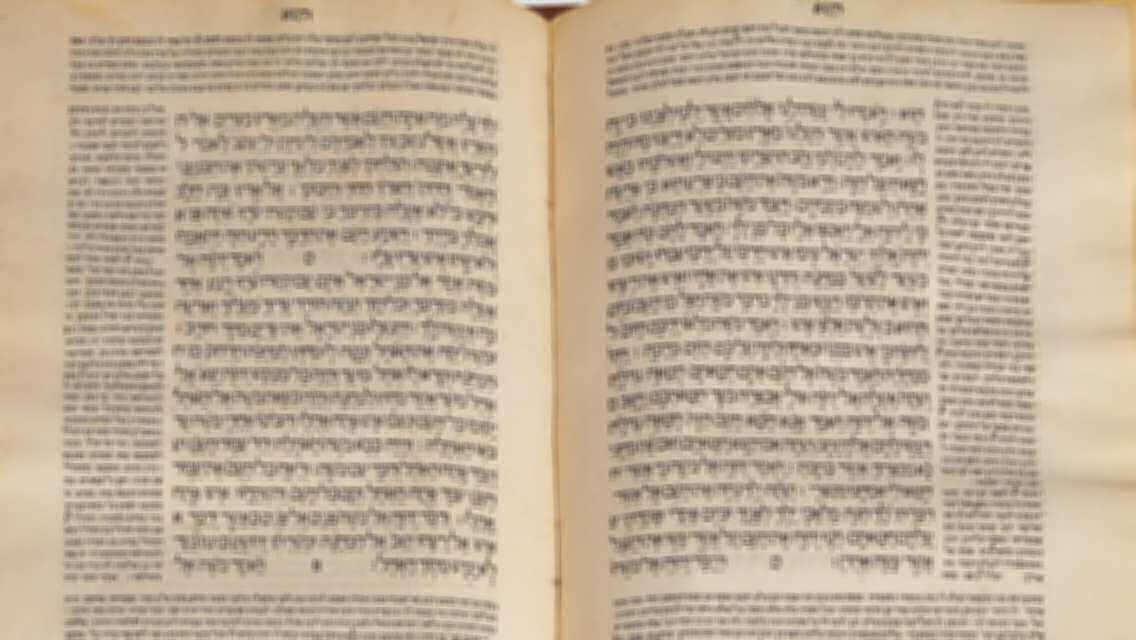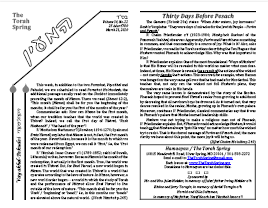This Week’s Sponsors
Mr. and Mrs. Jules Meisler
in memory of Jules’ father
Irving Meisler a”h
Elaine and Jerry Taragin
in memory of Asriel Taragin a”h
Harold and Gilla Saltzman,
in memory of his father
Yosef Noach ben Yitzchak Isaac z”l
This week, in addition to the two Parashot, Vayakhel and Pekudei, we are scheduled to read Parashat Ha’chodesh, the additional passage usually read on the Shabbat immediately preceding the month of Nissan. There we read (Shmot 12:2), “This month [Nissan] shall be for you the beginning of the months, it shall be for you the first of the months of the year.”
Commentaries ask: How can Nissan be the first month, when our tradition teaches that the world was created in Tishrei? Indeed, we call the first day of Tishrei, “Rosh Hashanah” / “the head of the year”!
R’ Moshe ben Nachman z”l (Ramban; 1194-1270; Spain and Eretz Yisrael) explains that Nissan is not, in fact, the first month of the year. Nevertheless, because it is the month in which we were redeemed from Egypt, we can call it “first,” i.e., the “first month of our redemption.”
R’ Yitzchak Isaac Chaver z”l (1789-1852; rabbi of Suvalk, Lithuania) writes, however: Because Nissan is the month of the redemption, it actually is the first month. True, the world was created in Tishrei. But, for Bnei Yisrael, a new world began in Nissan. The world that was created in Tishrei is a world that operates according to the laws of nature. In Nissan, however, a new world order began -- a world in which the study of Torah and the performance of Mitzvot allow Bnei Yisrael to live outside of the laws of nature. “This month shall be for you the ‘Rosh’ / ‘beginning’ or ‘head’,” i.e., in this months our “heads” are elevated above the natural world. (Si’ach Yitzchak p.265)
“On six days, work may be done, but the seventh day shall be holy for you, a day of complete rest for Hashem … Moshe said to the entire assembly of Bnei Yisrael, saying: ‘This is the word that Hashem has commanded, saying: … Every wise-hearted person among you shall come and make everything that Hashem has commanded: the Mishkan …’” (35:2, 4, 10-11)
The Gemara (Shabbat 31b) teaches that the Melachot / labors or activities that are prohibited on Shabbat are those that were necessary for the construction or functioning of the Mishkan / Tabernacle in the desert. Rashi z”l writes (in his commentary to Shabbat 5a) that this connection is learned from the juxtaposition of Shabbat and the Mishkan in our Parashah [as seen in the above verses].
Why should the Melachot prohibited on Shabbat be learned from the Mishkan? Moreover, the Zohar teaches that those same Melachot were used by Hashem to create the world. How should we understand that, since Hashem obviously does not perform physical labor?
R’ Avraham Zvi Kluger shlita (Chassidic Mashpia in Bet Shemesh, Israel) explains: Hashem implanted in Creation the possibility that we can find His Presence within it. Indeed, that was the purpose of Creation. And, while Hashem’s Presence could be sensed most intensely in the Mishkan (and, later, the Bet Hamikdash), it also can be found throughout His Creation. The possibility of “finding” Hashem in Creation and in the Mishkan is the common denominator between them to which the Zohar alludes.
R’ Kluger continues: It is clear from our Sages’ teachings that they did not look down on “work.” To the contrary, they valued work, because, when a person performs his work in accordance with Halachah, he is bringing spirituality into Creation. He is, quite literally, building a “Mishkan,” a place where Hashem is revealed. Notably, the word “Melachah” / “labor” or “work” shares a root with “Mal’ach” / “angel.”
On Shabbat, however, we are instructed not to work, not even in order to build the Bet Hamikdash. On Shabbat, explains R’ Kluger, Hashem reveals His Presence to us (referred to as an “awakening from Above”); we do not need to go searching for Him using our own labors (an “awakening from below”). Moreover, the revelation on Shabbat takes place in the realm of “Machshavah” / “thought” or “intellect,” not in the realm of “Ma’aseh” / “deed.” Creation and the building of the Mishkan / Bet Hamikdash both “rested” on Shabbat, because that is not how the revelation is meant to occur on that day. In line with this, the Torah prohibits only “Melechet Machshevet” / “thoughtful work” on Shabbat (as defined by Halachah). (Yichud Ha’Shabbat III p.61)
“The hundred talents of silver were to cast the sockets of the Sanctuary and the sockets of the Partition; a hundred sockets for a hundred talents, a talent per socket.” (38:27)
The Gemara (Menachot 43b) teaches that one is obligated to recite 100 Berachot every day. R’ Michel Zilber shlita (Rosh Yeshiva of the Zvhil yeshiva in Yerushalayim) quotes R’ Menachem Recanati z”l (1223-1290; Italian Kabbalist), who writes that the “secret” of the 100 Berachot is connected with the 100 Adanim / sockets that held the posts making up the walls of the Mishkan. Thus, if one recites 100 Berachot, it is as if he assembled the Mishkan. [Until here from R’ Recanati]
R’ Zilber explains: We read (Devarim 10:12), “Now, Yisrael, Mah / what does Hashem, your Elokim, ask of you? Only Le’yir’ah / to fear Hashem …” The Gemara cited above states that “Mah” can be read as “Me’ah” / “one hundred” -- a hint that one should recite 100 Berachot a day. Further, notes R’ Zilber, since the subject of the verse is having Yir’ah / fear or awe of Hashem, we can infer that reciting 100 Berachot a day is a means to develop that trait. This, he notes further, may answer the question that the Gemara asks elsewhere (Berachot 33b), “How can the verse say, ‘What does Hashem, your Elokim, ask of you? Only to fear Hashem’? Is that a small request?” The answer is: Yes! If one recites 100 Berachot a day, Yir’ah of Hashem will come easily.
R’ Zilber continues: In this light, we see a connection between 100 Berachot and the 100 Adanim. The word “Adanim” (sockets) hints to the Divine Name Aleph-Dalet-Nun-Yud, which is associated with the Divine Attribute of Justice; hence, withYir’ah. We read, for example (Malachi 1:6), “If I [G-d] am a Father, where is My honor, and if I am Adonim / a Master, where is Yir’ah of Me?”
R’ Yaakov ben Asher z”l (the “Ba’al HaTurim”; 14th century) writes that King David established the recitation of 100 Berachot daily in response to a plague that was killing 100 of his subjects each day. It follows, writes R’ Zilber, that reciting 100 Berachot a day has a life-giving force. This, again, connects the 100 Berachot with the 100 Adanim, for our Sages teach that during the entire time that the Mishkan was under construction, not one of Bnei Yisrael passed away. This was, in particular, in the merit of the Adanim, which, say our Sages, were made from the half-Shekel coins that Bnei Yisrael donated. [The Torah says about the half-Shekel donations (Shmot 30:12), “So that there will not be a plague among them.”] The Mishkan was given as an atonement for the sin of the Golden Calf, which brought death back to the world (after it briefly was abolished when the Torah was given). When one recites 100 Berachot daily, it is as if he lays down the 100 Adanim and stands up the posts of the Mishkan, thus bringing life to the world. (Ba’yam Darech: Ma’amarei Ha’mishkan No. 36)
Thirty Days Before Pesach
The Gemara (Ta’anit 29a) states: “When Adar enters, joy increases.” Rashi z”l explains: “They were days of miracles for the Jewish People -- Purim and Pesach.”
R’ Chaim Friedlander z”l (1923-1986; Mashgiach Ruchani of the Ponovezh Yeshiva) observes: Apparently, Purim and Pesach have something in common, and that commonality is a source of joy. What is it? Also, asks R’ Friedlander, we read in the Torah sections describing the Ten Plagues that Hashem wanted Pharaoh to acknowledge Him. Why was that important to Him?
R’ Friedlander explains: One of the most foundational “Ways of Hashem” is that His Honor will be revealed in this world no matter what man does. Indeed, at times, His Honor is revealed as a result of the actions of the wicked -- not merely despite their actions. This occurred, for example, when Haman was hanged on the very same gallows that he had made for Mordechai. This teaches that, not only can the wicked not foil Hashem’s plans, they themselves are tools in His hands.
The very same lesson is demonstrated by the story of the Exodus. Pharaoh hoped to prevent Bnei Yisrael’s savior from growing to adulthood by decreeing that all newborn boys be drowned. As it turned out, that very decree resulted in the savior, Moshe, growing up in Pharaoh’s own palace. Moreover, continues R’ Friedlander, classical commentaries say that it was in Pharaoh’s palace that Moshe learned leadership skills.
Hashem was not trying to make a religious man out of Pharaoh, R’ Friedlander explains. But, if Pharaoh would acknowledge Hashem, it would teach us that Hashem always “gets His way,” no matter how much the wicked try to resist. That is the shared message of Purim and Pesach. And, the more clarity we have about this point, the more joy it will bring us. (Siftei Chaim: Mo’adim p.249)
Find Other Issues
Hama'ayan's archives are being rebuilt. Check back soon.

